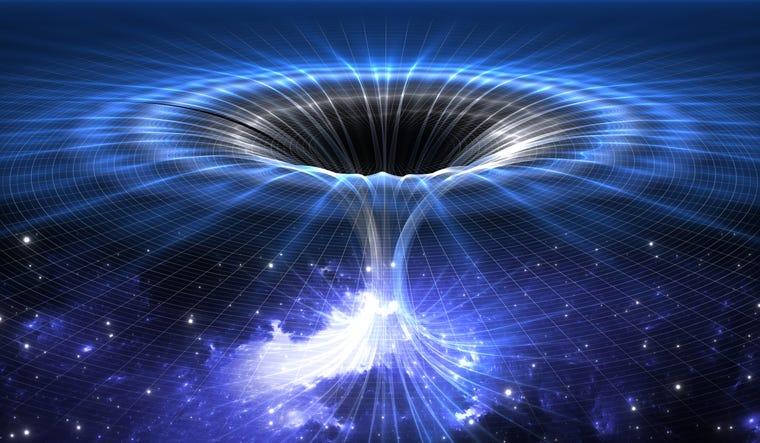Hendrik Casimir’s idea for an experiment was simple: bring two metallic objects extremely close together and wait. Spontaneously, as if by magic, the objects will be drawn together. No external forces, no pushes or pulls, no action of gravity or tension or magnetism. The objects simply get closer. The reason? An unlimited source of vibration sitting in the very vacuum of spacetime.
This landmark experiment, first devised by Casimir just after World War II—and only realized 25 years ago—paved the way for scientists to witness the manifestations of quantum theory in a real, practical way. Quantum fields and their vibrations power our modern-day understanding of physics, from subatomic interactions to the evolution of the entire universe. And what we learned, thanks to Casimir’s work, is that infinite energy permeates the vacuum of space. There are many ideas in the science fiction universe that propose using vacuum energy to power a starship or other advanced kind of propulsion, like a warp drive. While these ideas are still dreams, the fact remains that a simple experiment, devised in 1948, set fire to our imaginations and our understanding of the universe.

Casimir, a Dutch physicist, had spent his graduate years with his advisor, Niels Bohr, one of the godfathers of quantum physics, and had picked up a liking for this new, extraordinary theory of the cosmos. But as quantum theory evolved, it started to make extremely strange statements about the universe. The quantum world is weird, and its ultimate weirdness is normally invisible to us, operating at scales well below our normal human perception or experimentation. Casimir started to wonder how we might be able to test those ideas.
He went on to discover a clever way to measure the effects of ever-present infinite quantum fields merely using bits of metal held extremely close together. His work showed that quantum behavior can manifest in surprising ways that we can measure. It also showed that the strangeness of quantum behavior is real and can’t be ignored, and what quantum mechanics says about the workings of the universe—no matter how bizarre—must be believed.
Quantum Fields Are Otherworldly, But Very Real
One of the lessons of the quantum world is that particles, like electrons, photons, neutrinos, and whatnot, aren’t what they seem to be. Instead, each of the particles that we see in nature is actually just a piece of a much larger, grander entity. These grander entities are known as quantum fields, and the fields soak every bit of space and time—all throughout the universe—the same way that oil and vinegar soaks a piece of bread.

There is a quantum field for every kind of particle: one field for the electrons, one for the photons, and so on. These fields are invisible to us, but they make up the fundamental building blocks of existence. They are constantly vibrating and buzzing. When the fields vibrate with enough energy, particles appear. When the fields die down, the particles disappear. Another way to look at this is to say that what we call a “particle” is really a localized vibration of a quantum field. When two particles interact, it’s really just two pieces of quantum fields interacting with each other.
There’s no such thing as a true vacuum; wherever you go, there are always vibrating quantum fields.
These quantum fields are always vibrating, even when those vibrations aren’t strong enough to produce a particle. If you take a box and empty out all of the stuff—all the electrons, all the photons, all the neutrinos, all the everything—the box is still filled with these quantum fields. Since those fields vibrate even in isolation, that means the box is filled with invisible vacuum energy, also known as zero-point energy—the energy of these fundamental vibrations.
In fact, you can calculate how many vibrations are in each of these quantum fields … and the answer is infinity! There are small ones, medium ones, big ones, and gigantic ones, all flopping on top of each other continuously, as if spacetime itself was boiling at the subatomic level. This means that the vacuum of the universe really is made of something. There’s no such thing as a true vacuum; wherever you go, there are always vibrating quantum fields.
A Simple Experiment Involves Multiple Infinities
This is where Casimir’s experiment comes in: If you take two metal plates and stick them really, really close together, the quantum fields between those plates must behave in a certain way: the wavelengths of their vibrations must fit perfectly between the plates, just like the vibrations on a guitar string have to fit their wavelengths to the length of the string. In the quantum case, there are still an infinite number of vibrations between the plates, but—and this is crucial—there are not as many infinite vibrations between the plates as there are outside the plates.
How does this make sense? In mathematics, not all infinities are the same, and we’ve developed clever tools to be able to compare them. For example, consider one kind of infinity where you add successive numbers to each other. You start with 1, then add 2, then add 3, then add 4, and so on. If you keep that addition going forever, you’ll reach infinity. Now consider another kind of addition, this one involving powers of 10. You start with 101, then add to it 102, then 103, then 104, and keep going.
| Casimir’s experiment brings two metallic objects extremely close together. The objects will be drawn together because of vibrations in the quantum field and no other force. |
Again, if you keep this series going on forever, you’ll also reach infinity. But in a sense you’ll “get” to infinity faster. So by carefully subtracting these two sequences, you can get a measure of their difference even though they both go to infinity.
Using this clever bit of mathematics, we can subtract the two kinds of infinities—the ones between the metal plates and the ones outside—and arrive at a finite number. This means that there really are more quantum vibrations outside the two plates than there are inside the plates. This phenomenon leads to the conclusion that the quantum fields outside the plates push the two plates together, something called the Casimir effect in Hendrik’s honor.
The effect is incredibly small, roughly 10-12 Newtons, and it requires the metal plates to be within a micrometer of each other. (One Newton is the force which accelerates an object of 1 kilogram by 1 meter per second squared.) So, even though Casimir could predict the existence of this quantum effect, it wasn’t until 1997 that we were finally able to measure it, thanks to the efforts of Yale physicist Steve Lamoreaux.
In this experimental setup, which can fit on a kitchen countertop, the plates don’t magically pull themselves together. Instead it’s the infinite vibrating quantum fields of spacetime pushing them together from the outside.
We don’t normally see or sense or experience the Casimir effect. But when we want to design micro- and nano-scale machines, we have to account for these additional forces. For example, researchers have designed micro-scale sensors that can monitor the flow of chemicals on a molecule-by-molecule basis, but the Casimir effect can disrupt the operations of this sensor if we didn’t know about it.
Scientists Are Exploring the Potential of Vacuum Energy
For several years, researchers have been investigating the possibility that we really can extract vacuum energy and use it for energy. A 2002 patent was awarded for a device that captures the electric charge from the Casimir experimental setup’s two metal plates, charging a storage battery. The device can be used as a generator. “To continuously generate power a plurality of metal plates are fixed around a core and rotated like a gyrocompass,” according to the patent.
The U.S. Defense Department’s Defense Advanced Research Projects Agency (DARPA) gave researchers $10 million in 2009 to pursue a better understanding of the Casimir force. Though progress in actually using vacuum energy continues to be incremental, this line of energy research could give rise to innovations in nanotechnology, such as building a device capable of levitation, researchers said at the time.
At the University of Colorado in Boulder, Garret Moddel’s research group has developed devices that produce power “that appears to result from zero-point energy quantum fluctuations,” according to the group’s website. Their device essentially recreates Casimir’s experiment, generating an electrical current between the two metal layers that researchers could measure, despite applying no electrical voltage.
As for Casimir himself, who was immersed in a quantum revolution unfolding at Leiden University, he had a tendency to downplay the importance of his own work. In his autobiography, Haphazard Reality, Casimir said, “The story of my own life is of no particular interest.” And his monumental 1948 paper designing his experiment ends with the simple statement, “Although the effect is small, an experimental confirmation seems not infeasable and might be of a certain interest.”
In fact, his initial insight did not make a big splash on the scientific community, nor were there glowing popular press accounts of his experiment. Part of the reason was Casimir’s own modesty, and another is that he soon left academic research to pursue a career in industry. But despite these humble beginnings, his work cannot be understated.
Today, we continue to refine Casimir’s original experimental setup, searching for any cracks in our theories, and we use it as a foundation to explore ever more deeply the fundamental nature of the cosmos.






